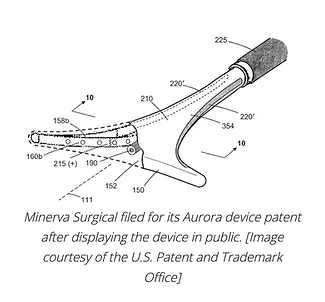
A new court ruling offers a cautionary tale for device developers eager to show off their prototypes before securing the proper patents.
The U.S. Court of Appeals for the Federal Circuit yesterday upheld a lower court’s ruling against Minerva Surgical in a patent dispute with Hologic.
Both courts decided that Minerva’s Aurora device for endometrial ablation came into public use when the company displayed prototypes at the 2009 American Association of Gynecologic Laparoscopists (AAGL) Global Congress of Minimally Invasive Gynecology.
Minerva displayed and demonstrated the devices at a booth during the 2009 gathering — characterized in the ruling as the industry’s Super Bowl — but didn’t file to patent the device until 2012.
In 2017, Minerva accused Hologic and subsidiary Cytyc Surgical of infringing the patent. Hologic responded by saying the claim wasn’t valid because the device had already been in public use, pointing to the 2009 AAGL event.
“Minerva’s disclosure of these devices spanned several days and included Minerva showcasing them at a booth, in meetings with interested parties, and in a technical presentation,” the appellate judges wrote in the latest ruling. “Minerva did not disclose the devices under any confidentiality obligations, despite the commercial nature of the event. Second, at the time of the public use, the technology was ‘ready for patenting.’ Specifically, Minerva had created working prototypes and enabling technical documents describing the claimed technology.”
In the months leading up to the 2009 AAGL event, Minerva started testing the device, which was effectively ready for use in patients.
The lower court ruled that the device was ready to be patented at the time of the AAGL event. And because Minerva was showing it off and touting its benefits, the court ruled that the device was in public use well before the patent application, which invalidated the patent.
Minerva appealed the decision, saying the lower court erroneously declared the device to have been in public use, but lost the appeal.
Though the device wasn’t being used to treat patients, Minerva displayed and demonstrated it at the show to members of the public while detailing how the device worked.
“The ‘in public use’ element of the bar is met if the invention ‘was accessible to the public or was commercially exploited’ by the inventor,” the judges wrote in the latest ruling, quoting language from prior rulings that set precedent. “… ‘An invention is in public use if it is shown to or used by an individual other than the inventor under no limitation, restriction, or obligation of confidentiality.’”
You can download the full ruling as a PDF from the court’s website. (The case is separate from a dispute between Minerva and Hologic that went to the U.S. Supreme Court in 2021.)
And the next time you’re packing prototypes for a trade show, consider whether your first stop should be the U.S. Patent and Trademark Office.
Comments